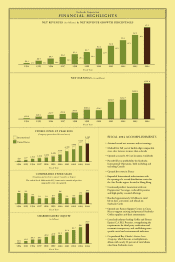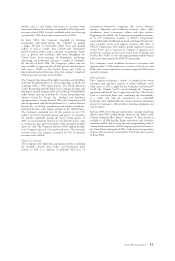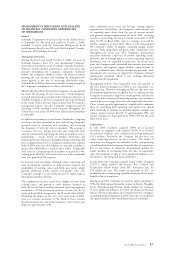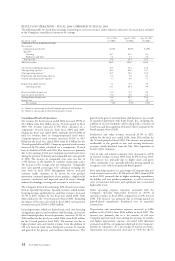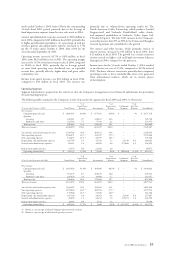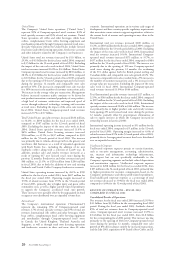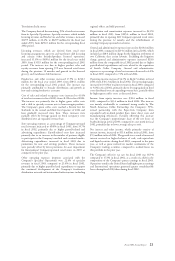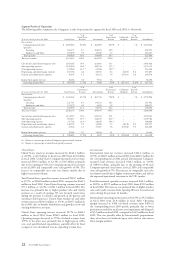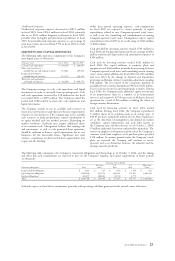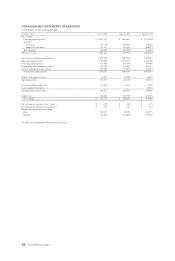Starbucks 2004 Annual Report Download - page 6
Download and view the complete annual report
Please find page 6 of the 2004 Starbucks annual report below. You can navigate through the pages in the report by either clicking on the pages listed below, or by using the keyword search tool below to find specific information within the annual report.Fiscal 2004 Annual Report 17
MANAGEMENT’S DISCUSSION AND ANALYSIS
OF FINANCIAL CONDITION AND RESULTS
OF OPERATIONS
General
Starbucks Corporation’s fi scal year ends on the Sunday closest
to September 30. The fi scal year ended on October 3, 2004,
included 53 weeks, with the 53rd week falling in the fi scal
fourth quarter. Fiscal years 2003 and 2002 each had 52 weeks.
Fiscal year 2005 will have 52 weeks.
Management Overview
During the fi scal year ended October 3, 2004, all areas of
Starbucks business, from U.S. and international Company-
operated retail operations to the Company’s specialty businesses,
delivered strong fi nancial performance, and innovation was
prevalent throughout the Company’s operations. Starbucks
believes the Company’s ability to achieve the balance between
growing the core business and building the foundation for
future growth is the key to increasing shareholder value.
Starbucks fi scal 2004 performance provides a strong example of
the Company’s commitment to achieve this balance.
Historically, the primary driver of the Company’s revenue growth
has been the opening of new retail stores, both Company-
operated and licensed, in pursuit of the Company’s objective to
establish Starbucks as the most recognized and respected brand
in the world. With a presence today in more than 30 countries,
management believes that the Company’s long-term goal of
operating 15,000 Starbucks retail locations throughout the
United States and at least 15,000 stores in International markets
is achievable.
In addition to opening new retail stores, Starbucks is targeting
to increase revenues generated at new and existing Company-
operated stores by attracting new customers and increasing
the frequency of visits by current customers. The strategy is
to increase fi rst year average store sales and comparable store
sales by continuously improving the level of customer service,
maintaining a steady stream of product innovation and
improving the speed of service through training, technology and
process improvement. For U.S. Company-operated stores opened
in fi scal 2004, fi rst year sales volumes are currently estimated at
greater than $800,000 as a result of these efforts. Comparable
store sales for Company-operated markets increased by 10%,
making fi scal 2004 the 13th consecutive year with comparable
store sales growth of 5% or greater.
In licensed retail operations, Starbucks shares operating and
store development experience to help licensees improve the
profi tability of existing stores and build new stores, which
generate additional royalty income and product sales. The
Company’s strategy is to selectively increase its equity stake as
International markets develop.
The combination of more retail stores, higher revenues from
existing stores, and growth in other business channels in
both the United States and International operating segments
resulted in a 29.9% increase in total net revenues for the 53
weeks of fi scal 2004, compared to the 52 weeks of fi scal 2003.
Excluding the impact of the extra sales week in fi scal 2004,
total net revenues increased 27.3%. Both of these revenue
growth measures were above the Company’s three to fi ve year
target of approximately 20%.
Since additional retail stores can leverage existing support
organizations and facilities, the Company’s infrastructure can
be expanded more slowly than the rate of revenue growth
and generate margin improvement. In fi scal 2004, operating
income as a percentage of total net revenues increased to 11.5%
from 10.4% in fi scal 2003, and net earnings increased by
46.0%, compared to fi scal 2003. These results demonstrated
the Company’s ability to improve operating margin despite
pressures from rising dairy and green coffee commodity costs
throughout the fi scal year. The Company’s International
operations delivered a full year of positive operating results,
primarily due to leverage gained on most operating expenses
distributed over an expanded revenue base. In recent fi scal
years, the Company made substantial infrastructure investments
in corporate and regional support facilities and personnel, as
well as established more effi cient distribution networks. Such
investments were necessary to support the Company’s planned
international expansion, which is now realizing substantial
benefi t from this foundation.
Management believes that comparable store sales growth of
the level acheived during fi scal 2004 is not sustainable over
the long term. However, management believes that new store
development opportunities on a global basis are suffi cient for the
Company to maintain a high level of unit growth and that the
execution of the current retail operating strategy can continue to
increase fi rst year average store sales and comparable store sales.
These revenue growth opportunities, coupled with continuous
focus on controlling both operating and capital costs, should
allow Starbucks to continue to modestly improve margins and
achieve annual revenue growth of approximately 20% and
annual earnings per share growth of 20%–25% for the next
three to fi ve years.
Acquisitions
In July 2004, Starbucks acquired 100% of its licensed
operations in Singapore and acquired 49.9% of its licensed
operations in Malaysia, for a combined total of approximately
$12.1 million. Previously, the Company did not have any
equity ownership interests in these entities. The results of
operations for Singapore are included in the accompanying
consolidated fi nancial statements from the date of acquisition.
For its investment in Malaysia, management applied the
equity method of accounting from the date of acquisition,
since the Company is able to exert signifi cant infl uence over
the investee’s operating and fi nancial policies.
In July 2003, the Company acquired Seattle Coffee Company
(“SCC”), which includes the Seattle’s Best Coffee® and
Torrefa zione Ita lia® brands, from AFC Enterprises, Inc. for
$70 million in cash. The results of operations of SCC are
included in the accompanying consolidated fi nancial statements
from the date of acquisition.
During fi scal 2003, Starbucks increased its equity ownership to
50% of its International licensed operations in Austria, Shanghai,
Spain, Switzerland and Taiwan, which enabled the Company
to exert signifi cant infl uence over their operating and fi nancial
policies. For these operations, the Company refl ected a change in
accounting method during fi scal 2003, from the cost method to
the equity method, in the consolidated fi nancial statements.

